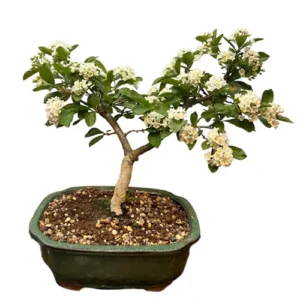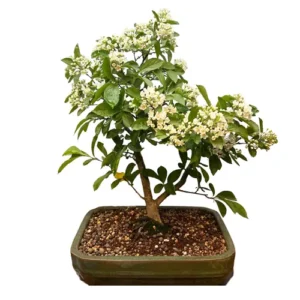Celtis sinensis
Hackberry Bonsai
Native to Korea, Japan and East China. Celtis sinensis are spreading deciduous trees, popular for upright and informal bonsai styles. Its minute orange fruits ripen to a mahogany colour. Hackberry bonsais also boast striking bark and sparkling green leaves.
Hackberry Bonsai Care Tips
Placement
Place Hackberry in the full sun but be mindful of a hot summer day leaving it dried out. For temperatures below -5 degrees C, frost protection is advised.
Watering
Water your Hackberry bonsai regularly across the growing season the moment the surface of the soil feels dry. Be sure to keep the soil moist across the winter as well. As a tropical species, it can be kept in a dryer than average environment, if doing so, misting will go a long way for the health of your bonsai. This can be achieved by using a mister to spray the leaves, as well as placing a gravel tray under the pot to create a more humid microclimate around the tree.
Feeding & Fertilising
During the growing season, feed your Hackberry bonsai once every two to three weeks.
Pruning & Wiring
Pruning should take place between the spring and the end of the summer. Overlong branches need cutting back and new shoots can be shortened to three or four buds.
Hackberry bonsai are suitable for an array of styles including cascade and broom. Apply the wires in spring or autumn, be mindful that most shaping can be done through pruning. We recommend using wires with a thickness that matches the thickness of the branch: if the wire you choose is too thick you will damage the bark. If it is too thin, it won’t be effective.
Repotting
Repotting your tree is an important way to provide a fresh and suitable soil mix and ensure appropriate root health. In early spring, repot your Hackberry bonsai every two to three years.
Trees that are ready for repotting will require root pruning, a suitable new pot and appropriate soil mix.
When repotting, do not cut back the root mass by a large amount, and choose a well-draining soil mix that has a neutral or slightly higher PH value of 5-6 but not over 7. We tend to use a mixture of different speciality bonsai soils on our trees. Every species is different so please contact us for free soil-mix advice or to take advantage of our repotting service.
Bonsai make for a one-of-a-kind indoor plant offering elegance, nature and art all in one minute form. Across an array of exquisite and erudite species, they all demand their own specific care and cultivation needs in order for their beauty to flourish. We have an extensive library of care guides for indoor bonsai trees so you can make an informed and considered choice. It’s not about selecting the perfect bonsai, it’s about selecting the perfect bonsai for you.
Hackberry Bonsai - Typical Queries
How to propagate Hackberry Bonsai?
Hackberry bonsai can be propagated by seeds, cuttings and layering. Cuttings should be sown in the late Spring to the Summer. Air layering should also take place in Spring. Sow seeds in the Autumn.
Do Hackberry bonsai get pests and diseases?
Generally speaking, if cultivated in Europe, Hackberry should be pretty trouble-free. Only weak trees will incur caterpillars and red spiders.
Can you keep a Hackberry bonsai outdoors?
A Chinese Hackberry will be fully hardy in temperate climates. This being said, if your bonsai is imported from China they should be placed indoors and be treated as such.





















